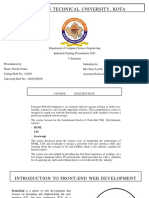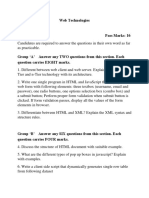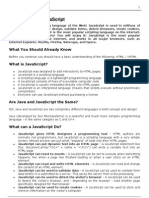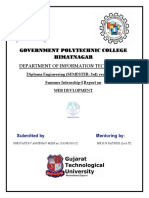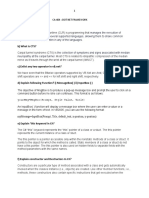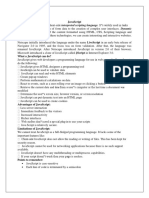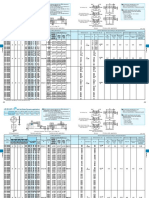Back-End Web Development
A Seminar II report submitted in
partial fulfillment of the requirements
for the Degree of
B.Tech.
in
Computer Engineering
Submitted by
Ansari Ali Zakwan Ali Imran
DEPARTMENT OF COMPUTER ENGINEERING
S.S.V.P.S.’s B.S. DEORE COLLEGE OF ENGINEERING, DHULE
2022-23
I
� Back-End Web Development
A Seminar II report submitted in
partial fulfillment of the requirements
for the Degree of
Bachelor of Technology
in
Computer Engineering
Submitted by
Ansari Ali Zakwan Ali Imran
Guided by
Prof: Bharti D Patil
DEPARTMENT OF COMPUTER ENGINEERING
S.S.V.P.S.’s B.S. DEORE COLLEGE OF ENGINEERING, DHULE
2022-23
II
� S.S.V.P.S.’s B.S. DEORE COLLEGE OF ENGINEERING,
DHULE
DEPARTMENT OF COMPUTER ENGINEERING
CERTIFICATE
This is to certify that the Seminar II entitled ‘Back-End Web Development’
has been carried out by
Ansari Ali Zakwan Ansari
Under my guidance in partial fulfillment of the degree of Bachelor of
Technology in Computer Engineering of Dr. Babasaheb Ambedkar
Technological University, Lonere during the academic year 2022-23. To the
best of my knowledge and belief this work has not been submitted
elsewhere for the award of any other degree.
Date:
Place: Dhule
Seminar Co-ordinator Guide
Prof. B. S. Parakh Prof. Bharti D Patil
Head Principal
Prof. B. R. Mandre Prof. Dr. H. D. Patil
III
� ACKNOWLEDGEMENT
First of all, I am indebted to the GOD ALMIGHTY for giving me an
opportunity to excel in my efforts to complete this seminar on time.
I am extremely grateful to our Principal Prof. Dr. H. D. Patil, and
our College, S.S.V.P.S.’s B. S. Deore College of Engineering, Dhule and
our HOD Prof. B. R. Mandre, Head of Department of Computer
Engineering, for providing all the required resources for the successful
completion of my seminar.
My heartfelt gratitude to my seminar guide Prof. Bharti D Patil,
Senior Lecturer, Computer Engineering, for her valuable suggestions and
guidance in the preparation of the seminar report.
I express my thanks to Teachers, all staff members and my Friends
for all the help and co-ordination extended in bringing out this seminar
successfully in time.
I will be failing in duty if I do not acknowledge with grateful thanks
to the authors of the references and other literatures referred to in this
seminar.
Last but not the least; I am very much thankful to my Parents who
guided me in every step which I took.
Thanking You
Ansari Ali Zakwan Ansari
IV
�Table of Contents
ABSTRACT.........................................................................................................................1
1. INTRODUCTION..........................................................................................................2
2. LITERATURE SURVEY..............................................................................................4
2.1 Skills you need to become a back end web developer...............................................4
2.1.1 Web Development Languages........................................................................5
2.1.2 Data Base & Cache.........................................................................................6
2.1.3 Server..............................................................................................................7
2.1.4 API(Rest&Sope)……………………………………………………………………………………………8
2.2 Top Back-end Web development Technologies........................................................9
2.1 Php.....................................................................................................................9
2.3 Python................................................................................................................9
2.4 Mongo DB..............................................................................................................9
3. Difference Between Front-end and Back-end web Development.................................10
3.1 Key Difference.......................................................................................................11
3.2 What is Front-End Web Development....................................................................11
3.3 What is Back-End Web Development....................................................................12
3.3.1 Features of Back-End Web Development.....................................................12
.4 Advantages and disadvantages of Back-End Web Development............................13
V
�VI
� Figure Index
1.1 Back-End Architecture………………………………………..
2.1 Back-End Technologies……………………………………….
3.1 Front End VS Back End……………………………………….
3.2 Front-End Development Tools………………………………...
3.3 Back-End Development Tools…………………………………
1
� ABSTRACT
Back-end Development refers to the server-side development. It focuses on
databases, scripting, website architecture. It contains behind-the-scene
activities that occur when performing any action on a website. It can be an
account login or making a purchase from an online store. Code written by
back-end web developers helps browsers to communicate with database
information.
2
� Chapter – 1
INTRODUCTION
1.1 What is Backend Web Development?
Back-end Web Development refers to the server-side development. It
focuses on databases, scripting, website architecture. It contains behind-the-
scene activities that occur when performing any action on a website. It can
be an account login or making a purchase from an online store. Code written
by back-end web developers helps browsers to communicate with database
information.
fig : 1.1 Back-End Architecture
3
�As the backend isn’t limited by the browser, the variety of programming
languages can be used to build it. Here, the choice is up to the developer’s
preference.
The 2000s’ is the epoch of the rise of scripting/ dynamic programming
languages. I offer you to learn the brief history of the oldest giants of
backend development.
Since the very beginning, Python stood out by its structure and philosophy
aimed at accelerating the process of product development. Python is simple
& readable, winning the hearts of thousands of developers and all-sized
companies over the world in such a way. Even though it has certain
performance problems, there are many ways to speed up Python.
The version Python 2.0 which introduced more transparency to the process
of development using Python was released in 2000.
The first incompatible version of Python 3.0 was released in 2008, after a
long testing period. This year, the Python community promises to stop
supporting the older versions, offering the developers to upgrade their
Python applications. Of course, for static websites without a scalability
intention using Python 2x isn’t critical. However, those who are aimed at
developing a product in the future adding new features should consider
Back end development dates back to the early days of the internet when
websites were static and only consisted of HTML pages. Server-side
scripting languages such as PHP, ASP, and JSP emerged in the early 2000s
to meet the growing complexity and demand for dynamic content and
interactivity. Python and Golang, due to their flexibility, scalability, and
efficiency, have also played important roles in back and front end
development since.
Node.js was introduced in 2009, ushering in a significant shift in back end
development by allowing software developers to create scalable, high-
performance dynamic websites using JavaScript, which was previously only
used for both frontend and backend development.
Cloud computing has recently revolutionized back end web developer
development by offering services such as serverless computing, database
hosting, and content delivery networks, which make it easier to build and
scale web applications
4
� Chapter -2
LITERATURE SURVEY
2.1.Skills You Need to Become a Backend Developer
Following are the skills you require to become a back end web developer:
1. Web Development Languages
2. Database and Cache
3. Server
4. API (REST & SOAP)
2.1.1Web Development Languages:
Backend engineer should know at least one server-side or Backend
programming language like Java, Python, Ruby, . Net etc.
2.1.2Database and Cache:
Knowledge of various DBMS technology is one of the important
Backend developer skills. MySQL, MongoDB, Oracle, SQLServer,
Redis are widely used for this purpose. Knowledge of caching
mechanisms like varnish, Memcached, Redis is a plus.
2.1.3Server:
Exposure to handling Apache, Nginx, IIS servers, Microsoft IIS
is desirable. A good background in Linux helps tremendously in
administering servers.
2.1.4API (REST & SOAP):
Knowledge of web services or API is also important for full stack
developers. Knowledge of creations and consumption of REST and
SOAP services is desirable.
5
�2.2.Top backend Web Development Technologies
When it comes to the types of backend technologies, we can find that a
plethora of these are being extensively used in the domain. I have compiled
a backend technologies list for you to understand the various technologies.
2.1.PHP
PHP stands for Hypertext Preprocessor and is a server-side scripting
language, meaning that programs created in it execute on web servers and
are not dependent on an online browser. C. Rasmus Lerdorf is the creator of
PHP, and its first version appeared in 1995. One of the most popular
languages developers use to create new apps, PHP is extensively used to
develop online applications.
Pros:
Open-source and free of cost
It's platform-independent
Faster loading rate
Cons:
It may not be suitable for all bigger web-based applications
Lacks debugging tools
Considered less secure relative to others
2.2. Python
Python is an interpreted, high-level, object-oriented, dynamically semantic
programming language. It is particularly desirable for Rapid Application
Development and usage as a scripting language to tie elements collectively
due to its high-level built-in data structures, robust typing, and dynamic
binding. Python's concise syntax prioritizes readability and simplifies
learning, lowering program maintenance costs.
6
�Pros
Open-source and free
Easy to learn
A vast collection of libraries
Cons
Has speed limitations
May have runtime errors
It consumes a substantial amount of space
2.3. JavaScript
JavaScript is a robust computer programming language. Its implementation
enables client-side scripts to interact with users and create dynamic pages,
and it is most extensively used as a component of web pages. It is an object-
oriented, lightweight, interpreted programming language. Many times it's
considered synonymous with Java backend technologies. LiveScript was the
original name of JavaScript, but Netscape renamed it to JavaScript, maybe
in response to the buzz that Java was causing. LiveScript, the predecessor to
JavaScript, debuted in Netscape 2.0 in 1995. Netscape, Internet Explorer,
and many web browsers all contain the general-purpose language's core.
Pros
Language is not complex
Effortless to implement
Has high interoperability
Cons
Substandard browser support
2.4 MongoDB
MongoDB is a cross-platform document-oriented database application. It is
also open source. MongoDB, a NoSQL database application, employs
documents that resemble JSON(JavaScript Object Notation is a lightweight
format for storing and transporting data) with alternative schemas.
MongoDB was created by MongoDB Inc. and is distributed under the
Server Side Public License, which some distributions consider non-free.
Pros
7
� Offers High speed
Provides flexible database
Has a good technical support
Cons
Faces memory limitation issues
Joins are not supported
May lead to corruption of data
Fig:2.1 Back-End Technologies
8
� Chapter-3
DIFFERENCE BETWEEN FRONT AND BACK-END
3.1 Key differences:
The front end is the interactive part of the website or application. The
Graphical User Interface (GUI) allows users to take actions as per
their wishes. Users can see and interact with the front end. The
backend of a website or an application cannot be seen by the users. It
collects the information from the users, processes, and handles the
functionality of the application.
The desirable work of a front-end developer is the designing of
layouts and the desirable work of a back end developer is to attain a
functional
Fig:3.1 . Front-End VS Back-End
Front end developers need to have an idea of the back end. Thus front
end development is not only about beauty. While back end
development is mostly about logic, calculations, servers, API’s and
testing. A collaboration between the front end developers and back
end developers is very crucial and data is passed through particular
data formats.
9
�3.2What is Frontend?
As the name says, Frontend is something that a user can see, interact and
experience. It majorly involves programming or coding the parts of the
website and applications that are visible to the user. The person who
develops the front end is known as a Front End Developer. The work of a
Front End Developer is to build on the User Interface and User Experience
designs which are the key elements of bringing design to life. Key skills of a
Front End Developer include knowing HTML, CSS, JavaScript, and
frameworks such as Angular JS, node js, etc. Along with this, knowledge
about the version control system like GIT and GITHUB adds to their
treasury. Figure 3.2 shows types of Front-end development tools. A Front-
End Developer is an imperative part of web development, as they provide
the structure needed for feasible working.
Fig:3.2 Front End Development Tools
10
�3.3What is Backend?
Backend or Backend development is like behind the scenes of a movie or
show or in our case, the frontend. Actions taken by the user are analyzed,
fetched, and delivered back by the backend through the codes written. The
person who develops the back end is known as the Back End Developer.
The major work of a Back End Developer includes linking every aspect of
the front end together and with the databases. The primary skills of a Back
End Developer include knowing back-end languages such as Python, Java,
Ruby, etc. Other skills include a sound understanding of Database
Management System (DBMS) and Application Program Interface(API).
Figure 3.3 shows the types of back-end development tools. The back end is
very crucial as it gives purpose or functionality to the beauty of an app or
website.
Fig:3.3 Back-End Development Tools
11
�3.3.1Features of Backend
Like the frontend, the backend also comes with multiple features that are
beneficial to the developers.
Databases: It involves storing of necessary data of the users.
Website Architecture: It involves understanding the goals that are
needed to make the application.
Scripting: It involves the proper formatting of the framework.
API: Application User Interface or APIs are tools that help in
communication between machines and deliver the necessary data .
12
� Chapter-4
ADVANTAGES AND DISADVANTAGES
4.1ADVANTAGES OF BACK-END DEVELOPMENT
Here are some of its advantages of back-end development in the software
development process.
RUNS IN DIFFERENT ENVIRONMENTS
Companies today deploy websites and web applications in a range of
environments. For starters, some businesses choose sites operating on database
servers, and others install online apps in the cloud. Around the same period,
more companies are now merging all hosting services to take advantage of
advantages such as improved capacity and scalability. The setup of the Web
server varies from network to network. The programmers also frequently
distribute workload server-side over multiple machines. The varying hosting
environments make customizing website backend essential for developers.
The backend consists of three critical elements of a website, i.e., application,
web server, and database, as mentioned previously. Each user should be able to
provide his / her login name and password while accessing a website’s user
interface. The username ID and the user’s password is checked via the runtime.
Similarly, any details that the user submits is processed in the backend
application in the repositories. The backend often retrieves data from the archive
and transfers the details to the web interface for the app view. Hence, a website’s
backend serves as its framework and enables the sharing of knowledge.
Nowadays, most programmers keep a website’s user interface and application
logic separate to simplify its development and maintenance. The application
logic also performs the routine data processing required by each firm in addition
to incorporating an application’s domain and infrastructure components. A web
site’s backend contains its logic for an application. The developers must,
therefore, focus on the development of the backend web to seamlessly switch
from one frontend to another, and make multiple user interfaces access the same
application logic .A website’s accessibility and user interface will, over the long
term, depend on its success. As noted earlier, the backend performs all tasks
required to make a website function. And the consistency of backend technology
can influence the user interface provided by a website. Any problems with the
backend code can lead to frequent website crashes, slow running of the site, and
similar performance issues. At the same time, small vulnerabilities in the
backend code will render the website susceptible to targeted ransomware attacks
and protection.
13
�When developing a website, programmers are required to write backend code to
add utility to the functionality of each frontend. For example, to add
functionality to a user login form, they must write code using a server-side
programming language. The backend code collects the values each time a user
enters his login credentials and compares them with the login data stored in
databases. Similarly, the backend code adds functionality to different forms,
profiles, and accounts. Without quality backend technology, thus, no website
will work.
DISADVANTAGES OF BACK-END DEVELOPMENT
While it may have its benefits, it also has some disadvantages. Following are
some of the disadvantages of back-end development.
No personalized automated operations: there is no choice for specialized atomic
services, which makes it impossible to solve the market problems.
Limited count operations: there are limited count operations that vary each time
and do not exceed 160.
Less control: Consumers have fewer network power that prohibits them from
executing those activities as they wish.
Security issues: If security is your primary concern, you should opt for a custom
backend cloud dedicated to you alone. You will need to formulate protection
strategies that can vary according to business models.
Send notifications delayed: Update updates may be postponed, often only up to
an hour.
It is also essential for developers to perform backend services by selecting the
correct language and framework for programming. Since they have the option to
choose from many programming languages on the server-side, the programmers
have to choose the language that meets all project needs. They also need to pick
the right web development framework and tools according to the programming
language specific to the server-side.
14
� Future of Back-End Web Development
Backend development is undergoing rapid change, with new technologies
and approaches emerging all the time. As businesses become more digital,
backend development is becoming increasingly critical to their success. In
this article, I take a closer look at the future of backend development,
exploring the latest trends and predictions for 2023.
Trend 1: The Rise of Serverless Architectures
One of the most exciting trends in backend development is the rise of
serverless architectures. This approach allows developers to focus on
writing code, without having to worry about managing servers or
infrastructure. As a result, serverless architectures can help to reduce costs,
improve scalability, and streamline development processes.
Trend 2: Containerization and Microservices for Improved Scalability and
Security
Another key trend is the increasing use of containerization and
microservices. These technologies allow developers to break down large
monolithic applications into smaller, more manageable services, making it
easier to update and maintain them. By using containerization and
microservices, businesses can also improve scalability, enhance security,
and reduce downtime
Trend 3: Staying Up-to-Date with the Latest Backend Development Skills
and Technologies
Finally, it's essential to stay up-to-date with the latest backend development
skills and technologies. This means keeping abreast of emerging trends and
experimenting with new approaches. In particular, there is a growing
demand for developers with expertise in cloud computing, distributed
systems, and DevOps practices.
15
� CONSLUSION
Back end development (often called the “server-side” development), is the
creation of everything that goes on behind the scenes of a website or
application that the user can’t see. Data is collected from external servers
and applications and filters this information back into the website to process
user requests. If you’re buying something online, you enter your information
into the website. That information will then be stored in a database that was
created on a server and will be processed to purchase your item. All of these
stages are part of backend development.
BIBLOGRAPHY
[1] https://www.siteforinfotech.com/
16
�[2] https://www.interviewbit.com/
[3] https://www.linkedin.com/
[4] https://www.geeksforgeeks.org/
17
�18
�19

